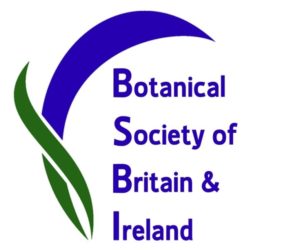Kirkcudbrightshire Botany Group at Kirkconnell Merse, 4th August 2022
The southern half of the merse, part of the site managed by RSPB, has not been grazed recently and we surveyed much of the site with RSPB personnel in attendance. In all, 12 of use covered two of the four monads in this area, specifically hoping to re-find Tasselweed Ruppia maritima and Brackish Water Crowfoot Ranunculus baudotii in the saltpans and brackish pools.
The merse is typical of Solway saltmarsh in that there are a number of distinct “steps” reflecting differing sea levels over the past centuries, each step having a particular community of plants. The site was dissected by numerous deep creeks and scattered bare mud patches, remnants of brackish water pools.
We tackled these in reverse starting at the highest step bordering the track, recording Tufted Vetch Vicia cracca and stands of Yorkshire Fog Holcus lanatus, Common Sow-thistle Sonchus arvensis with colonies of White Clover Trifolium repens, Autumn Hawkbit Scorzoneroides autumnalis and a single clump of False Fox Sedge Carex otrubae.
There was also a single stand of Tall Fescue Schedonurus arundinacea with its bright green leaves, purple node and very tall (2m) spreading flower panicle.
The next lower step is occupied by mid-marsh species including Creeping Bent Agrostis stolonifera, Elytrigia repens aggregate (I didn’t attempt to identify to species as this is a very complex group involving hybrids), Sheeps Fescue Festuca ovina and its larger counterpart Red Fescue F. rubra and of course White Clover again. There was a single clump of Red Clover Trifolium pratense, but unexpectedly no sedges of any description – I would have expected at least 3 saltmarsh species here, so rather a poor community. Scattered in amongst this were dense stands of Sea Clubrush Bolboschoenus maritimus, usually found lower down the merse and numerous scattered white heads of Parsley Water Dropwort Oenanthe lachenalii with its finely divided pinnate leaves, standing above the general level of the surrounding vegetation.
The next lower step was low marsh and here the species changed dramatically with abundant Common Saltmarsh Grass Puccinellia maritima, Sea Aster Aster tripolium , Sea Arrowgrass Triglochin maritimum, masses of the small Saltmarsh Rush Juncus gerardii (more about which later), Sea Purslane Glaux maritima and close to the actual shoreline Thrift Armeria maritima. Curled Dock Rumex crispus with its deep red fruits in a dense spike occurred here and in the preceding step. It was on the step that we lunched on the “comfort” of a large ash trunk overlooking a deep creek; and here was the only specimen of Sea Beet Beta maritima we saw on the site.
The lowest step corresponded to pioneer saltmarsh, a community also seen frequently in the bare mud of the saltpans at higher levels in the merse. Vegetation here covered about 50% or less of the ground and was dominated in various places by different plants. Notable were Sea Spurrey Spergularia maritima with both pink and white flowered plants, Glasswort or Samphire Salicornia spp (although the latter name can cause confusion with at least two other non-related species), Annual Sea-blite Suaeda maritima. Here we also noted a single rather sparse clump of the invasive Spartina anglica which normally spreads rapidly through this community, but here seemed unable to do so. In one of the creeks in the upper marsh we spotted a single clump of Celery-leaved Buttercup Ranunculus sceleratus. Some of the saltpans, particularly close to the upper mash areas, help large colonies of what appeared to be Round-fruited Rush Juncus compressus, so we completed a TPP form detailing habitat, colony size, etc.
This rush is considered rare here and a Nationally Threatened species (declining colonies). But closer examination at home was confusing as the distinction between this and J. gerardii is difficult to say the least. I’m not convinced and need to send samples way for expert determination.
Scattered through almost all of these steps, there were varying numbers of Common Scurvy Grass Cochlearia officinalis aggregate and Spear-leaved Orache Atriplex prostrata. Incidentally, we tasted the Scurvy Grass, Glasswort and Sea-blite, finding all palatable!
The various sections of the merse held only 33 species, a poor total for such an area. Controlled grazing would probably increase the species diversity of the merse by reducing the height and vigour of some of the taller or more rapidly growing species, and allow less competitive species to get access. Many of the other Solway marshes hold considerably more species (Mersehead, Auchencairn, Rough Firth, Fleet Bay and Creetown) including several scarce or rare species for the VC.
As a footnote, Sarah and Ken, who provided all the above photos, followed up my grid reference for Sweet Flag Acorus calamus on the merse near Kirkconnell House and found two clumps.
David Hawker
BSBI county recorder for Kirkcudbrightshire VC73

